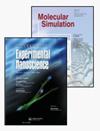DFT Study of adsorption and diffusion of CO 2 on bimetallic surfaces
IF 2
4区 化学
Q4 CHEMISTRY, PHYSICAL
引用次数: 0
Abstract
ABSTRACTIn this work, adsorption and diffusion of CO2 on the Cu (111) surface, and Cu (111) surface modified by tungsten (W) and platinum (Pt) were studied and their electronic properties were examined using Density-functional theory (DFT) simulations. To specify the most favourable adsorption sites, the adsorption energies and distances of CO2 on various surface sites including on top, hexagonal close-packed (HCP), and bridge were calculated. The crystal orbital overlap population analysis was employed to investigate the properties and characteristics of chemical bonding. The computed Bader atomic charges of CO2 molecules on different catalyst surfaces indicated that the Cu-W alloy surface had a higher net charge transfer than other surfaces. This result suggests that the adsorption of CO2 on the Cu-W alloy surface is more powerful than on other surfaces. The outcomes indicated that the CO2 adsorption on the surfaces follows the order of Cu-W alloy > Cu-Pt alloy > Cu. Also, the diffusion on the alloy surfaces was faster than on the Cu surface, which confirms the adsorption energy.KEYWORDS: Adsorptionbimetallic surfacescopperplatinumtungsten AcknowledgmentThe authors of this work appreciate the financial support of the Ferdowsi University of Mashhad Research Council, Mashhad, Iran (Grant No. 3/58558).Disclosure statementNo potential conflict of interest was reported by the author(s).Additional informationFundingThis work was supported by Ferdowsi University of Mashhad: [grant number 3/58558].二氧化碳在双金属表面吸附和扩散的DFT研究
摘要本文研究了CO2在Cu(111)表面和钨(W)和铂(Pt)改性Cu(111)表面的吸附和扩散,并利用密度泛函理论(DFT)模拟研究了它们的电子性能。为了确定最有利的吸附位点,计算了CO2在不同表面位点上的吸附能和吸附距离,包括顶部、六方密装(HCP)和桥。采用晶体轨道重叠居群分析方法研究了其化学键的性质和特点。计算不同催化剂表面CO2分子的Bader原子电荷表明,Cu-W合金表面比其他表面具有更高的净电荷转移。结果表明,Cu-W合金表面对CO2的吸附比其他表面更强。结果表明,CO2在表面的吸附顺序为Cu- w合金> Cu- pt合金> Cu。合金表面的扩散速度比Cu表面快,证实了吸附能的存在。本文作者感谢伊朗马什哈德Ferdowsi大学马什哈德研究委员会(Grant No. 3/58558)的资助。披露声明作者未报告潜在的利益冲突。本研究由马什哈德Ferdowsi大学资助:[资助号3/58558]。
本文章由计算机程序翻译,如有差异,请以英文原文为准。
求助全文
约1分钟内获得全文
求助全文
来源期刊

Molecular Simulation
化学-物理:原子、分子和化学物理
CiteScore
3.80
自引率
9.50%
发文量
128
审稿时长
3.1 months
期刊介绍:
Molecular Simulation covers all aspects of research related to, or of importance to, molecular modelling and simulation.
Molecular Simulation brings together the most significant papers concerned with applications of simulation methods, and original contributions to the development of simulation methodology from biology, biochemistry, chemistry, engineering, materials science, medicine and physics.
The aim is to provide a forum in which cross fertilization between application areas, methodologies, disciplines, as well as academic and industrial researchers can take place and new developments can be encouraged.
Molecular Simulation is of interest to all researchers using or developing simulation methods based on statistical mechanics/quantum mechanics. This includes molecular dynamics (MD, AIMD), Monte Carlo, ab initio methods related to simulation, multiscale and coarse graining methods.
 求助内容:
求助内容: 应助结果提醒方式:
应助结果提醒方式:


